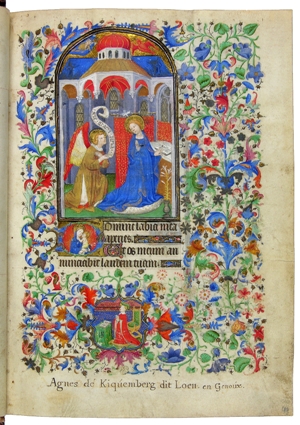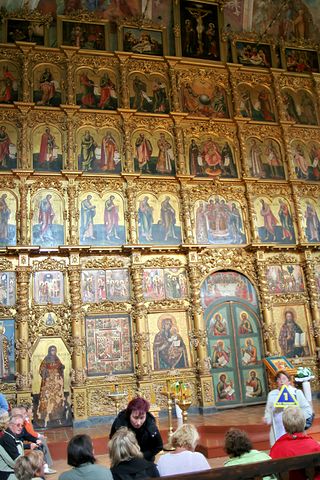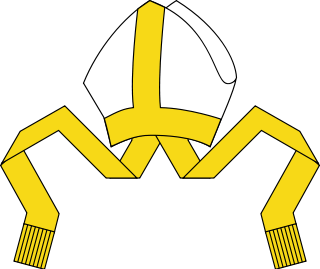
A prayer rope is a loop made up of complex woven knots formed in a cross pattern, usually out of wool or silk. The typical prayer rope has thirty-three knots, representing the thirty-three years of Christ's life. It is employed by monastics, and sometimes by others, to count the number of times one has prayed the Jesus Prayer.

A monastery is a building or complex of buildings comprising the domestic quarters and workplaces of monastics, monks or nuns, whether living in communities or alone (hermits). A monastery generally includes a place reserved for prayer which may be a chapel, church, or temple, and may also serve as an oratory, or in the case of communities anything from a single building housing only one senior and two or three junior monks or nuns, to vast complexes and estates housing tens or hundreds. A monastery complex typically comprises a number of buildings which include a church, dormitory, cloister, refectory, library, balneary and infirmary, and outlying granges. Depending on the location, the monastic order and the occupation of its inhabitants, the complex may also include a wide range of buildings that facilitate self-sufficiency and service to the community. These may include a hospice, a school, and a range of agricultural and manufacturing buildings such as a barn, a forge, or a brewery.

A mantle is an ecclesiastical garment in the form of a very full cape that extends to the floor, joined at the neck, that is worn over the outer garments. Especially in the case of Elijah, it was likely a tallit, a Hebrew garment that housed the fringes still seen today which are also translated at “the hem of His garment” in the New Testament. It is also likely that further ecclesiastical garments were based originally on this one.

In the practice of Christianity, canonical hours mark the divisions of the day in terms of fixed times of prayer at regular intervals. A book of hours, chiefly a breviary, normally contains a version of, or selection from, such prayers.

A monk is a person who practices religious asceticism by living a monastic lifestyle, either alone or with any number of other monks. A monk may be a person who decides to dedicate their life to serving other people and serving God, or to be an ascetic who voluntarily chooses to leave mainstream society and live their life in prayer and contemplation. The concept is ancient and can be seen in many religions and in philosophy.

The Byzantine Rite, also known as the Greek Rite or the Rite of Constantinople, is a liturgical rite that is identified with the wide range of cultural, devotional, and canonical practices that developed in the Eastern Christian church of Constantinople.

Christian monasticism is the devotional practice of Christians who live ascetic and typically cloistered lives that are dedicated to Christian worship. It began to develop early in the history of the Christian Church, modeled upon scriptural examples and ideals, including those in the Old Testament, but was not mandated as an institution in the scriptures. It has come to be regulated by religious rules and, in modern times, the Canon law of the respective Christian denominations that have forms of monastic living. Those living the monastic life are known by the generic terms monks (men) and nuns (women). The word monk originated from the Greek μοναχός, itself from μόνος meaning 'alone'.

January 7 - Eastern Orthodox liturgical calendar - January 9

The Euchologion is one of the chief liturgical books of the Eastern Orthodox and Byzantine Catholic churches, containing the portions of the services which are said by the bishop, priest, or deacon. The Euchologion roughly corresponds to a combination of the missal, ritual, and pontifical as they are used in Latin liturgical rites. There are several different volumes of the book in use.
Ecclesiastical titles are the formal styles of address used for members of the clergy.
Eastern Orthodox Christianity in Ireland is the presence of Eastern Orthodox Christians in the Republic of Ireland. Within Ireland, there are several formally organized parishes belonging to various autocephalous churches, primarily the Ecumenical Patriarchate of Constantinople, the Romanian Orthodox Church, and the Russian Orthodox Church.

John Michael Botean is an American prelate of the Romanian Greek Catholic Church. Since 1996 he has been eparch in the Romanian Catholic Eparchy of St. George, the second to hold that position in the United States' sole Romanian Byzantine Catholic eparchy and the only Romanian Rite eparchy outside of Romania.
Eastern Orthodox worship in this article is distinguished from Eastern Orthodox prayer in that 'worship' refers to the activity of the Christian Church as a body offering up prayers to God while 'prayer' refers to the individual devotional traditions of the Orthodox.

Eastern Christian monasticism is the life followed by monks and nuns of the Eastern Orthodox Church, Oriental Orthodoxy, the Church of the East and Eastern Catholicism. Eastern monasticism is founded on the Rule of St Basil and is sometimes thus referred to as Basilian.
The degrees of Eastern Orthodox and Eastern Catholic monasticism are the stages an Eastern Orthodox monk or nun passes through in their religious vocation.

Văratec Monastery is a Romanian Orthodox women's monastery located in north-eastern part of the country, in Văratec village, Agapia Commune, Neamț County. It is situated at 12 km from Târgu Neamț and 40 km from Piatra Neamț. It is the largest community of nuns in Romania, with more than 400 nuns living there.
The Romanian Greek Catholic Eparchy of St. George is a Romanian Greek Catholic Church ecclesiastical jurisdiction or eparchy of the Catholic Church in the United States and Canada. The incumbent eparch is John Michael Botean. The cathedral church of the eparchy is St. George's Cathedral, Canton, Ohio. There are fourteen parishes and five missions in the United States. There are two parishes in Canada.
The Lity or Litiyá is a festive religious procession, followed by intercessions, which augments great vespers in the Eastern Orthodox and Byzantine Catholic churches on important feast days. Following a lity is another liturgical action, an artoklasia, and either of these terms may be used to describe both liturgical actions collectively.

The Coptic Rite is an Alexandrian liturgical rite. It is practised in the Coptic Orthodox Church and the Coptic Catholic Church.






















